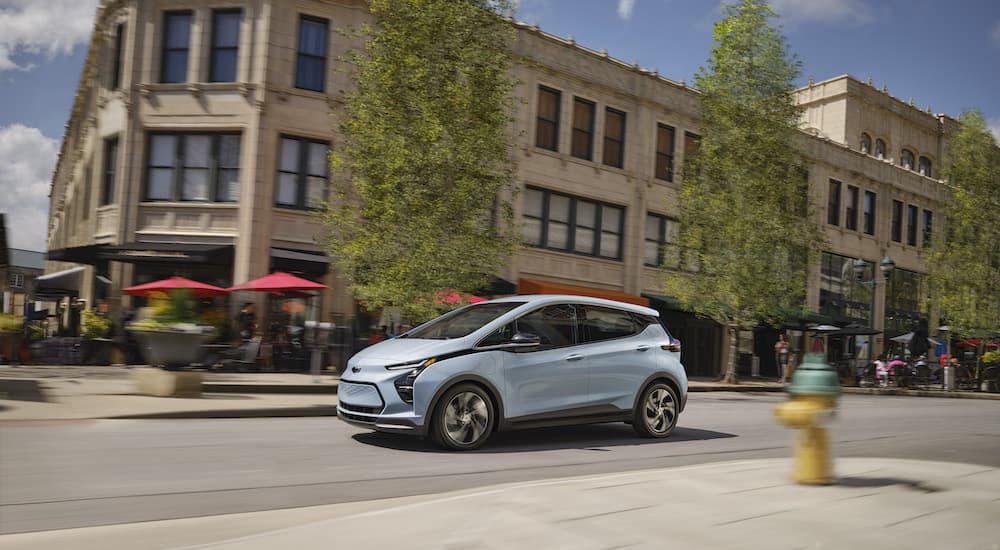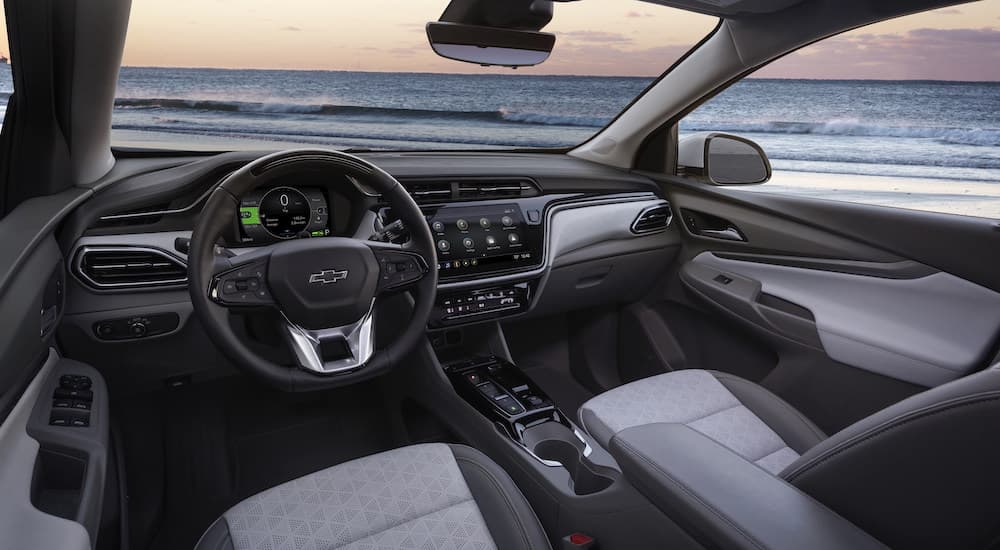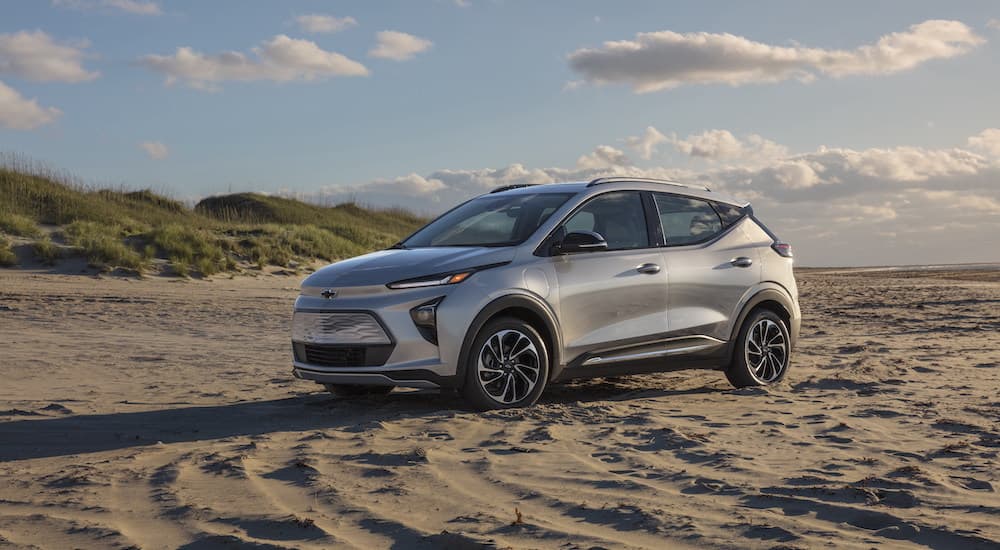If you see a Chevy Bolt for sale, you might think you’re looking at just another battery electric vehicle (BEV); think again. The Chevy Bolt represents the culmination of a new strategy enacted by General Motors built on the Ultium platform, designed specifically for their all-electric lineup. Automakers are always looking toward technology and innovation to find new ways to differentiate their vehicles from competitors. This is like any other consumer product where manufacturers must deliver a value proposition to potential customers.
One way to stand out is the price point, meaning that the product is less expensive than those offered by the competition. Another way is to provide a more technologically advanced product than its rivals. Chevy has created the Bolt, a pair of BEVs built on the Ultium platform, that succeed in being both more affordable than comparable models while offering technological advances that make them safer, higher-performing, and more fun to drive than you might expect from a BEV.
What is Ultium?
Ultium is not a new member of the X-Men, an element found on the periodic table, or a brand of energy drink. It’s actually the name that GM has given to its platform for developing BEV vehicles across all GM brands and vehicle types. As GM CEO Mary Barra explains, “Our team accepted the challenge to transform product development at GM and position our company for an all-electric future. What we have done is build a multi-brand, multi-segment EV strategy with economies of scale that rival our full-size truck business with much less complexity and even more flexibility.”
To this end, GM has invested $2.6 billion into Ultium. Included in this investment is the development of battery cell manufacturing plants in Michigan, Ohio, and Tennessee. This will allow GM to gain the benefit of manufacturing battery cells for their own vehicles, which are designed from the ground up to maximize the potential of each new BEV. Ultium itself involves not just manufacturing but design and innovation as well. GM placed the Ultium battery architecture into a set of cells located safely and securely in the undercarriage of each BEV. Gone are the days of losing valuable passenger and trunk space to lithium-ion battery packs. This modular design makes building the BEVs easier and replacing cells simpler and more affordable.
In addition, placing the battery pack inside the vehicle frame helps shield it from damage in the event of a collision. Finally, positioning it in the undercarriage creates a more balanced distribution of weight inside the vehicle. By providing a 50/50 weight distribution and a lower center of gravity, the BEV will have improved handling, acceleration, and range. One of the main goals of Ultium is to reduce BEV costs. As these vehicles become more affordable, more consumers will take advantage of owning one, leading to a greener, cleaner, and more efficient future. Through Ultium, GM has driven battery cell costs below $100 per kWh. These savings will be passed to consumers via reduced pricing for BEVs produced by GM brands. Also, Ultium will make BEVs less complex than internal combustion vehicles, giving them fewer moving parts. This will save money in repairs and maintenance costs for owners.
Where Did It All Begin?
Chevy is not new to the BEV market. In many ways, Chevy helped pioneer the electric revolution in the United States with the introduction of the Volt in 2011. This hybrid sedan provided an all-electric range of up to 40 miles. As a result, most commuters who used local roads experienced incredible fuel efficiency and greater market penetration for GM, which was just starting to dip its toes into the segment of hybrids and BEVs. Building on this experience, Chevy introduced the Bolt EV in 2017, followed by the Bolt EUV in 2022. Meanwhile, the Volt was phased out after the 2019 model year as GM shifted focus to pure BEVs instead of hybrid models.
Chevy’s Two Bolt Models Equal the Best of Both Worlds
The Chevy Bolt represents capturing economies of scale and scope alluded to by GM CEO Mary Barra. The economies of scale are captured through Chevy’s massive production capacity, while economies of scope are realized through design commonalities amongst various products to reduce costs and, with that, MSRP per vehicle. As a result, the company has produced two different versions of the Bolt while keeping the price down. The Bolt EV was produced first and modeled on a subcompact hatchback design. It provides up to 259 miles of range on a full charge, making it an ideal model for a commuter or student who wants to maximize the range of their vehicle.
The Bolt EUV is built on a subcompact SUV design and provides more passenger space than the Bolt EV, making it perfect for families that need to take advantage of the 5-passenger seating capacity. Even though it is larger and heavier than the Bolt EV, the Bolt EUV still has a very impressive range of up to 247 miles when fully charged. Both Bolt models demonstrate how Chevy can reduce production costs by using certain design commonalities between them. For example, the Chevy Bolt EV and Bolt EUV use the same 65 kWh liquid-cooled lithium-ion battery pack and permanent magnet AC synchronous electric motor located by the front axle. This motor delivers 200 hp and 266 lb-ft of torque. This saves the time and expense of designing and manufacturing different motors and battery packs for each vehicle.
All of these savings are reflected in the pricing of the 2023 Bolt EV and Bolt EUV. When most automakers are increasing prices across product lines with a focus on BEVs, Chevy has not only held the line when it comes to these two models but actually reduced prices for consumers. The base model 2023 Bolt EV 1LT has an MSRP of $25,600, which is noticeably less than the MSRP of the 2022 Bolt EV 1LT, at $32,495. The entry-level 2023 Bolt EUV LT has an MSRP of $27,200, over $7,000 less than the $34,495 price tag of the 2022 Bolt EUV LT. This significant price reduction reflects the success of GM’s Ultium strategy, as battery production costs have been reduced year-on-year with the savings passed onto customers of the Bolt EV and Bolt EUV.
Chevy’s Bev Future Is Shockingly Bright
Chevy began its commitment to efficient vehicles over 10 years ago when it introduced the Volt. That dedication and hard work is paying off today, as the lessons learned from the hybrid Volt have been applied by GM to the BEVs they make today. By taking advantage of vehicle architecture and design to improve the placement of battery packs and using innovation to make those same battery cells more efficient, they’ve improved performance while reducing cost. Today, the Chevy Bolt EV and Bolt EUV are two of the most affordable BEVs on the road. In addition to unparalleled efficiency, you get all the smart tech features that innovation breeds, like the one pedal driving mode and Super Cruise. The Chevy Bolt demonstrates how bright an all-electric future can be with the Ultium platform leading the way.






